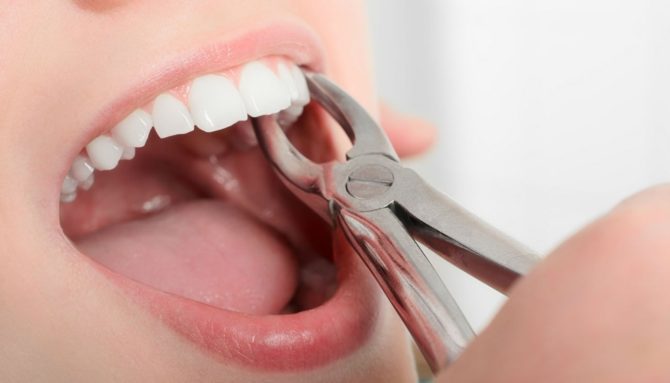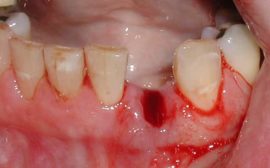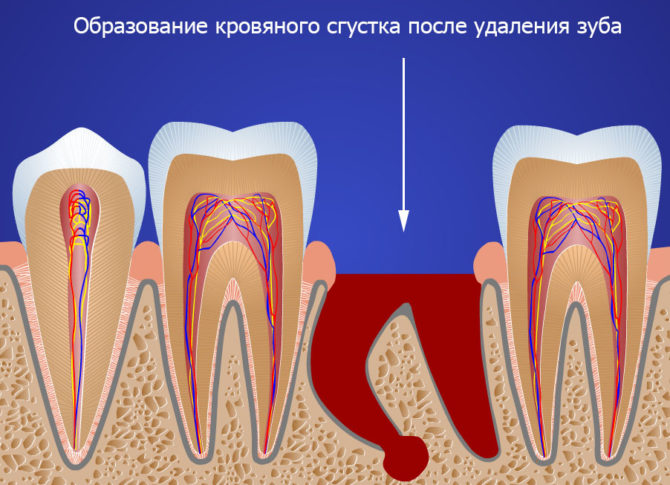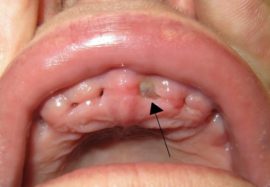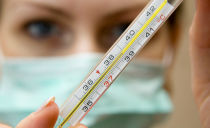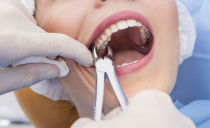Code of practice and rules to be followed after tooth extraction
The operation to remove the tooth is perceived by many as a very unpleasant, but not so serious procedure. But this is also surgical intervention and a kind of stress for the body, therefore, after removing the tooth, the dentist must clearly instruct the patient when he can eat, drink or smoke, what drugs should be used after the end of the anesthesia.
Content
Actions immediately after the tooth extraction procedure
After tooth extraction, the body forms a natural defense against pathogenic microorganisms that can get into the resulting wound - a blood clot accumulates in the hole. Some patients, looking in the mirror at the place where the tooth was pulled out, think that it is accumulated pus or food, and the hole should be rinsed, cleaned with a swab or a toothpick. But this cannot be done, by such actions a person destroys the formed barrier, and bacteria freely penetrate the gums. The clot eventually resolves naturally.
A gauze swab placed on the resulting hole should be discarded immediately after bleeding is completed (after 2-3 hours). Isolation of the sucrose may continue longer, but it has a light pink tint. If you leave the swab for a long time, it will accumulate microflora and can contribute to infection of the wound. But Remove the application with extreme caution so as not to tear out a blood clot with it.
Within several hours after tooth extraction, the action of the anesthetic is completed, and the pain syndrome from damage to living tissues begins to appear. Normally, the pain goes away after a few days, but with severe attacks, you can use the pain medication prescribed by your doctor. According to dentists, excruciating pain can be avoided by applying a couple of stitches. When removed without complications, this is rarely done, but this way you can prevent the loss of a blood clot with the formation of a dry hole, and further inflammation of the soft tissues.
Prescribed Drugs
Even if the removal procedure is successful, the dentist may prescribe some drugs to prevent complications and pain relief. You need to drink only those pills that the doctor prescribed. You should discuss in advance with him how often they can be taken and how many days. Long-term use of certain analgesics is very harmful to the stomach.
To prevent pain upon completion of anesthesia, you can take the pill immediately after tooth extraction. But usually successful, simple removal does not cause severe pain.
What drugs are prescribed:
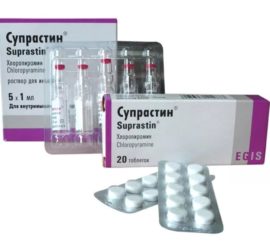 Ointments with the effect of accelerating regeneration.
Ointments with the effect of accelerating regeneration.- Antiseptic solutions for rinsing the mouth (Chlorhexidine). You can’t actively rinse your mouth - this way you can wash off a clot. You should do the bath: collect liquid in the mouth and leave it there for a minute, without performing active movements. Such a procedure is necessarily prescribed to those patients who have carious teeth. It is also shown if complex removal or treatment of flux was performed.
- Antibiotics are not prescribed to all patients, but to those who are at increased risk of developing inflammation, or who already have a clear infection in their mouth.The dosage and duration of treatment with an antibacterial drug, as well as the type of drug should always be chosen by the doctor.
- Suprastin is prescribed after tooth extraction to reduce the inflammatory reaction and prevent swelling.
If the patient has chronic hypertension, then after tooth extraction he must carefully monitor the pressure and take the necessary medications during his jumps. High blood pressure can cause bleeding.
Edema Prevention
In case of damage to the tissues of the jaw that can occur during surgery, the patient’s blood flow increases to the place where the tooth was removed. So the body provides enhanced local immunity: more leukocytes and immune components that can neutralize pathogenic microorganisms are supplied with blood to the wound. But because of this, a person develops edema, often this phenomenon is observed when pulling out the extreme molars.
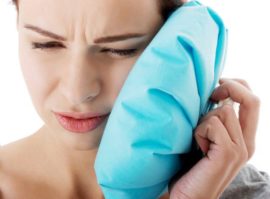 To prevent edema after removing a wisdom tooth, a cold compress should be applied to the place that underwent the intervention. The procedure is performed 3-4 times a day, one session should be no more than 5 minutes. As a compress, you can use a special heating pad with ice, a piece of ice or frozen meat wrapped in a towel. If the swelling does not subside on the fourth day after the operation, the doctor will prescribe Suprastin or another anti-allergic medicine.
To prevent edema after removing a wisdom tooth, a cold compress should be applied to the place that underwent the intervention. The procedure is performed 3-4 times a day, one session should be no more than 5 minutes. As a compress, you can use a special heating pad with ice, a piece of ice or frozen meat wrapped in a towel. If the swelling does not subside on the fourth day after the operation, the doctor will prescribe Suprastin or another anti-allergic medicine.
Only cold compresses can be applied to the operated area of the gums. Heat can not only cause bleeding, but can also lead to purulent inflammation of the tooth socket.
Eating after tooth extraction
In 2–5 hours after tooth extraction, it is already possible to eat, but precautionary measures should not be forgotten for the next few days. In the first day after extraction, you can’t drink and eat hotter, since an increase in the temperature of the mucosa leads to an intensification of blood supply and can provoke bleeding.
Products with a very sharp and pungent taste are undesirable; they can cause discomfort. You can drink plain water immediately after visiting dentistry, and patients who cannot be hungry for long are allowed to drink a glass of sour-milk drink to satisfy their hunger.
Chewing hard food for several days after tooth extraction hurts; it is better to replace it with liquid or soft products. Chewing on the side of the jaw where the operation is performed should not be done until the socket is tightened, otherwise food debris can penetrate the wound, rot there and become a medium for the propagation of microbes. Also, while chewing, you can catch a blood clot and violate the protection against infection.
Oral hygiene after tooth extraction
Very suspicious patients are afraid to care for their oral cavity after tooth extraction. They do not brush their teeth for a long time, believing that this can damage the wound. But non-compliance with hygiene rules can lead not only to the accumulation of soft, and then hard plaque, but also to the entry of pathogenic microbes into the well, followed by inflammation (alveolitis).
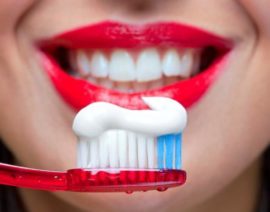 Oral hygiene after tooth extraction should be carried out in a standard way (using a brush, powder or paste), but before tightening the hole, you need to be extremely careful when cleaning the part of the jaw where the extraction was performed.
Oral hygiene after tooth extraction should be carried out in a standard way (using a brush, powder or paste), but before tightening the hole, you need to be extremely careful when cleaning the part of the jaw where the extraction was performed.
It is useful to rinse with homemade decoctions of herbs (calendula, chamomile), pharmacy disinfectant gums. But before the clot resolves, the active rinse is replaced with trays. Do not use dental floss near the socket of the extracted tooth.
Smoking and alcohol
Smoking patients are always interested in whether it is possible to smoke after tooth extraction. Dentists believe that the best way to prevent complications is to give up cigarettes in the first three days after surgery.Nicotine is a substance that causes vasospasm, and the dentition during surgery requires normal blood supply for the speedy healing of the hole.
Drinking alcohol is prohibited on the first day after tooth extraction. But if the dentist prescribes antibiotics or other medications, alcohol can be taken only at the end of the course of treatment. Large doses of alcohol with a loose hole can lead to hematomas on the gums and bleeding.
Additional procedures after tooth extraction
With the development of complications after tooth extraction, additional procedures have to be performed. If pus accumulates in the hole, the doctor will perform the following manipulations:
-
Sanitation of the hole - cleansing of purulent plaque, stuck pieces of food.
- Installation of drainage (ducts or gauze). The method helps to remove pus that continues to stand out from the hole.
- If necessary, the dentist stitches. To do this, use threads that resolve themselves after 10 days.
Physiotherapeutic procedures may be necessary to eliminate the pain, inflammation, and negative processes that occur in the damaged nerve (especially when removing the wisdom tooth).
General recommendations
All recommendations that dentists give after tooth extraction can be presented in this way:
| What to do after removal | What can not be done |
|---|---|
| Take prescription drugs | Self-medicate |
| Remove gauze swab in time | Remove blood clot |
| To make baths | Apply heat |
| Apply cold | Eat hot food |
| Perform hygiene procedures | Take a hot bath |
| Eat soft foods | Do hard physical work |
| Monitor the well-being and condition of the hole, if you suspect a complication, consult a dentist | Actively smoke and abuse alcohol. |
A repeated visit to the dentist is required in three cases: if a complex removal is made, a follow-up examination is prescribed, and alarming symptoms have arisen. The last item includes:
- Fever.
- Unremitting pain, its intensification, spreading to the bone tissue of the jaw or the appearance of shooting sensations several days after tearing.
- Blood clot loss within a few hours after removal.
- Isolation of pus from the wound.
- Severe redness of the gums due to the inflammatory process.
- Severe edema that spreads to the face and does not pass when taking Suprastin or applying a cold.
- Sensation of mobility of the dentition.
- Tingling sensation in the wound due to a fragment of tooth root left.
- The manifestation of severe adverse reactions from medications prescribed by your doctor.
If you use the services of an experienced dentist and follow the rules of behavior after tooth extraction, the risk of complications is minimized. This operation should be taken seriously, but do not give in to negative emotions, since stress can worsen the condition.
To avoid the procedure for removing the tooth, you should contact the dentist in time to perform medical procedures and eliminate tooth decay, eat right and follow the rules of hygiene.

